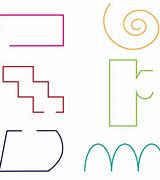geometry shapes
Geometry Shapes:
In Arithmetic, Mathematical shapes are the figures which exhibit the state of the articles we find in our regular daily existence. In calculation, shapes are the types of articles which have limit lines, points and surfaces. There are various kinds of 2d shapes and 3d shapes.
Shapes are additionally characterized regarding their routineness or consistency. An ordinary shape is generally even like a square, circle, and so on. Sporadic shapes are awry. They are likewise called freestyle shapes or natural shapes. For instance, the state of a tree is sporadic or natural.
In plane math, the two-layered shapes are level shapes and shut figures like circles, squares, square shapes, rhombus, and so forth. In strong math, the three-layered shapes are 3D square, cuboid, cone, circle and chamber. We can see this multitude of shapes in our everyday presence moreover. For instance books (cuboid shape), glasses (round and hollow shape), traffic cones (conelike shape, etc. In this article, you will learn different mathematical shapes and their definition alongside models. Definition:
Mathematical shapes are the figures which address the types of various articles. A few figures are two-layered, while some are three-layered shapes. The two-layered figures lie on just the x-pivot and y-hub, however 3d shapes lie on the x, y and z tomahawks. The z-pivot shows the level of the article. As we have proactively examined in the presentation, there are various shapes characterized in math.
To draw or plan any of these figures start with a line or a line portion or a bend. Contingent on the number and plan of these lines, we get various kinds of shapes and figures like a triangle, a figure where three line sections are associated, a pentagon (five-line fragments, etc. In any case, each figure is definitely not a total figure. Rundown of Mathematical Shapes:
Here is the rundown of various mathematical shapes that we learn in calculation.
Two Layered Shapes:
Triangle
Circle
Semi-Circle
Square
Square shape
Parallelogram
Rhombus
Trapezium
Kite
Polygons (Pentagon, Hexagon, Octagon, Nonagon, Decagon, and so on.)
Three Layered Shapes:
Circle
3D shape
Cuboid
Cone
Go through the various kinds of shapes in math alongside definitions here.
Triangle:
Triangle is a polygon, which is made of three sides and comprises of three edges and three vertices. Additionally, the amount of its inner points equivalents to 180o.
Circle:
Locus of all focuses at a decent separation from a reference main issue is known as a Circle.
Square:
Square is a quadrilateral where every one of the four sides and points are equivalent and the points at all the vertices are equivalent to 90° each.
Square shape:
A quadrilateral has two sets of inverse sides equivalent long and inside points are at the right points.
Parallelogram:
A parallelogram is a quadrilateral with two sets of equal sides and inverse points are equivalent in measure.
Polygons:
The majority of the three-layered shapes can be characterized as a bunch of vertices, lines that interface the vertices and countenances encased by these lines including got inside focuses. For the majority three layered shapes, faces are two-layered. Likewise, a few shapes in three aspects have bends surfaces. In three aspects, the essential shapes are:
Solid shape
Cuboid
Cone
Chamber
A point is a little speck which is the beginning stage of a line section. By definition, a line fragment is a piece of a line where a limited path is interfacing two focuses inside a line. Various quantities of line portions give us various figures and such figures might be either open figures or shut shapes or figures.
Mathematical shapes:
Open figures are inadequate shapes. To outline a shut figure one needs to meet both the beginning stage and finishing point. Open figures are likewise portrayed by utilizing line fragments or by bends however basically the lines will be broken. An open figure's beginning and endpoints are unique.









Comments